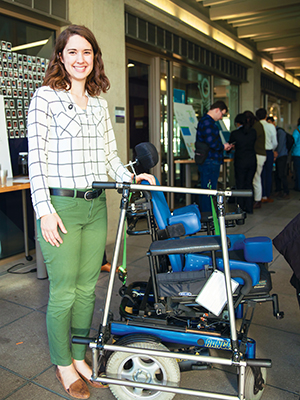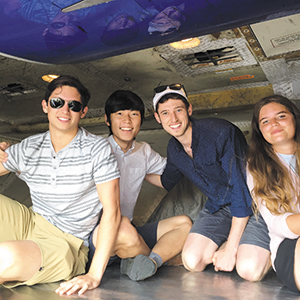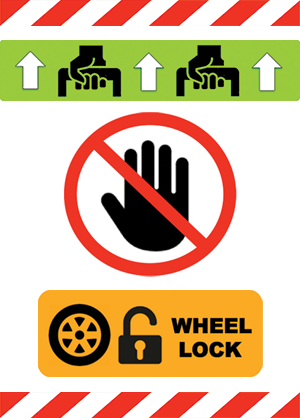Wheels Up
Northwestern students work to take the stress out of air travel for wheelchair users.
 When Jessica Lindsay and her family flew to London in 2017, her best friend, Northwestern Engineering graduate student Julia Savich, asked if she could come along—all in the name of research.
When Jessica Lindsay and her family flew to London in 2017, her best friend, Northwestern Engineering graduate student Julia Savich, asked if she could come along—all in the name of research.
“Traveling can be very stressful for anybody,” Lindsay says. “There are the normal things like making sure you pack everything and all that. Our family has even more stress.” Lindsay and her twin sister Jordan both have cerebral palsy and use wheelchairs, which makes traveling especially tricky.
“We always worry: Will the airline lose our chairs?” she says. “Will they take them apart to fit into the cargo hold? What if they break them?”
These are exactly the types of concerns and challenges that Julia Savich and her fellow Northwestern Engineering students are trying to solve in partnership with Chicago’s world-renowned Shirley Ryan AbilityLab, which has been ranked number one in rehabilitation by U.S. News & World Report for 27 consecutive years.
For more than two decades, Northwestern Engineering students have worked with the research hospital on solutions for people living with disabilities. Although Northwestern and Shirley Ryan AbilityLab, previously known as the Rehabilitation Institute of Chicago, are separate entities, the two often share resources and work toward common goals—including solving issues using human-centered design.
"The Shirley Ryan AbilityLab is an innovation hub. They’re really striving to do what’s not been done before— seeking new ways to help people with disabilities or the newly injured live better lives,” says Bruce Ankenman, co-director of Northwestern’s Segal Design Institute. “That fits with Northwestern Engineering’s goals.”
Using Human-Centered Design for Good
Exposure to human-centered design begins early in a Northwestern engineering student’s academic career. Every first-year student takes two quarters of Design Thinking and Communication through the Segal Design Institute. There they have opportunities to work with people with disabilities through the hospital.
"Every one of those 500 students will work on a real project for a real person with a disability. It’s life changing for the students,” Ankenman says. “The hospital has about 50 therapists who work with us each year. It’s an army of people.”
In their projects, the students first learn to listen to individuals from the disability community about the challenges they face in their lives; they then design, prototype, and iterate solutions. Past projects have ranged from a tool that enables a stroke victim to button a shirt with one hand to ways to make gardening easier for an arthritis sufferer.
“The students might not always find a solution,” Ankenman says, “but they need to learn, listen, and have empathy.”
Projects with the Shirley Ryan AbilityLab are so popular that students often work on individual design projects in upper-level courses or take on projects through Northwestern’s Design for America, a student initiative that creates local and social impact through interdisciplinary design.
"Many Northwestern students also come back as volunteers and interns as juniors or seniors,” Ankenman says. In increasing numbers, master’s program students like Savich are getting involved as well.
Old Friends, New Insights
 When Julia Savich entered the Master of Science in Engineering Design Innovation (EDI) program, she wanted to design a solution that would help her friend Jessica feel more included and less constrained by using a wheelchair. The two had first met during their first year at Palatine High School, about 30 miles outside of Chicago. Jessica is ambulatory but uses a manual wheelchair for long distances. Her twin sister Jordan uses a custom-built manual chair full time.
When Julia Savich entered the Master of Science in Engineering Design Innovation (EDI) program, she wanted to design a solution that would help her friend Jessica feel more included and less constrained by using a wheelchair. The two had first met during their first year at Palatine High School, about 30 miles outside of Chicago. Jessica is ambulatory but uses a manual wheelchair for long distances. Her twin sister Jordan uses a custom-built manual chair full time.
"I didn’t really think about how Jessica’s life was different then,” says Savich, who earned her bachelor’s degree in physics from Illinois Wesleyan University in 2016. “I just liked hanging out with her.”
In fall of 2016, Ankenman reached out to the new EDI master’s candidates with a potential project. The Shirley Ryan AbilityLab wanted help to make air travel more accessible for people with wheelchairs.
"It is a big issue when someone’s wheelchair is lost. It is not like they’ve lost their luggage,” Ankenman says. “It’s like they’ve lost their legs.” With her friend in mind, Savich jumped at the opportunity and started researching potential projects that could become her thesis.
An Idea Takes Wing
“I looked at the whole process of air travel—from getting out of a taxi to sitting on the plane to landing at a destination—to figure out the issues. I talked with people who use power wheelchairs and manual ones,” Savich says.
Instrumental in Savich’s work was Jessica Pedersen, a research associate professor and occupational therapist at the Shirley Ryan AbilityLab who served as a mentor and facilitated much of Savich’s research. Pedersen’s specialty is evaluating which type of wheelchair would best serve an individual’s needs. She also conducts research on wheelchair use and travel. For about nine months, the two met every other week and emailed regularly.
“I looked at the whole process of air travel—from getting out of a taxi to sitting on the plane to landing at a destination—to figure out the issues. I talked with people who use power wheelchairs and manual ones.”
"Jessica Pedersen had about 30 models of electric wheelchairs for Julia to check out,” Ankenman says. “That’s not the kind of access you typically can get as a graduate student. That let Julia consider every angle of the problem.”
Pedersen introduced Savich to several people who use wheelchairs so she could learn about their travel experiences. On one occasion, the two women learned that the man they were to meet had been admitted to Northwestern Memorial Hospital down the street. “Julia went to the hospital and spent a couple hours with him, talking about his needs,” Pedersen says. “She’s very mature and has a wonderful way of working with people with disabilities.”
Savich’s research also included talking with the Lindsay family. “Julia came over and interviewed my mom and me about what traveling is like for us, what works and what doesn’t,” Jessica Lindsay says. “We told her about our experiences with broken and lost wheelchairs.” The family suggested Savich fly with them on an upcoming trip to London to see their challenges for herself.
The trip was eye opening. “I had never considered how hard it would be to navigate an airport or even use the bathroom if you’re paralyzed from the waist down,” Savich says. “I’d never thought about how once you’re on the airplane, you’re not able to get out of your seat at all.”
Framing the Problem
Pedersen also helped Savich look at the issue from another point of view—that of the airline baggage handlers. Savich attended two training sessions held on a tarmac in Seattle to teach baggage handlers how to load wheelchairs.
"The Shirley Ryan AbilityLab, with its partner Open Doors Organization, got Julia that access,” Ankenman says. “When they call, the red carpet rolls out.”
Savich learned that motorized chairs, which are highly personalized and very expensive, could easily be damaged by airline baggage handlers. “Wheelchairs are users’ ‘bodies,’ and a damaged chair disrupts their lives beyond the airport,” she says.
Savich also traveled with Pedersen to Washington, D.C., for a meeting of the Rehabilitation Engineering and Assistive Technology Society of North America. There she gathered more new ideas from leading researchers on assistive technology for air travel.
"Jessica Pedersen was incredibly helpful to me. She knew all the stakeholders,” Savich says. “Northwestern’s proximity to the Shirley Ryan AbilityLab is amazing. I couldn’t have had this experience anywhere else.”
Savich leveraged her extensive research to create Paladin, a hollow steel frame to help baggage handlers safely store power wheelchairs. The lightweight frame attaches to the side of the wheelchair before it goes in the cargo hold, preventing baggage handlers from grabbing parts that tend to break and ensuring the chair is stored safely.
Sticking to It
 While working on her thesis, Savich heard that the work being done by a team of undergraduates in Northwestern’s intensive Design for America Summer Studio program dovetailed with hers. The team—Alex Bloom, Maxwell Leef, Sara Gnolek, and Jintae Park—had developed stickers to be placed on wheelchairs during travel. The colorful stickers can be applied to any type of wheelchair to provide baggage handlers with important information, such as safe lifting points, fragile parts, and how to unlock wheels.
While working on her thesis, Savich heard that the work being done by a team of undergraduates in Northwestern’s intensive Design for America Summer Studio program dovetailed with hers. The team—Alex Bloom, Maxwell Leef, Sara Gnolek, and Jintae Park—had developed stickers to be placed on wheelchairs during travel. The colorful stickers can be applied to any type of wheelchair to provide baggage handlers with important information, such as safe lifting points, fragile parts, and how to unlock wheels.
Bloom, a senior majoring in integrated engineering, says, “We met with Julia a couple of times to share resources and see how she was approaching the issue. It was great to exchange notes.”
"The stickers are a good way to raise awareness and hopefully minimize damage,” Savich says. “Having a standard communication method across wheelchair brands and power types means baggage handlers only have to learn one new handling technique, not one for each style of chair.”
The undergraduate group’s enthusiasm continued beyond the summer program, so Savich invited them to Northwestern’s 24-hour Integrated Design Innovation Challenge, hosted by the Shirley Ryan AbilityLab. “This project helped me confirm what I want to do for a career—design for social good,” says Bloom. His team hopes to market the stickers through their website.
Helping a Community
Northwestern students’ projects like the stickers and the wheelchair travel frame can make a tremendous difference in people’s lives, Pedersen says. “It’s a first step in the students’ careers, and it tells members of the disability community that their voices are being heard and there are people looking to make their lives better. It’s powerful.”
Since completing her degree, Savich has worked at Milwaukee Tool as a design researcher. She hopes to continue to refine her Paladin frame and wants to stay active in design for the disability community. “If you’re looking to really make an impact on someone’s life, working with people with disabilities is a great way to do it,” she says. “It’s all up front and personal, trying to create solutions, putting them in the hands of users, and seeing the joy on their faces.”
Savich’s friendship with the Lindsay family continues. “It’s great that Julia’s trying to make a difference for people like us,” Jessica Lindsay says. “She’s very smart, caring, and kind, and she puts others before herself. I feel honored that she had me in mind when she started this project.”
